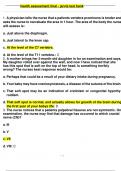Exam (elaborations)
Physical examination and health assessment 9th edition (jarvis, 2024) test bank, all chapters 1 - 32, complete newest version 2024
Physical examination and health assessment 9th edition (jarvis, 2024) test bank, all chapters 1 - 32, complete newest version 2024
[Show more]




